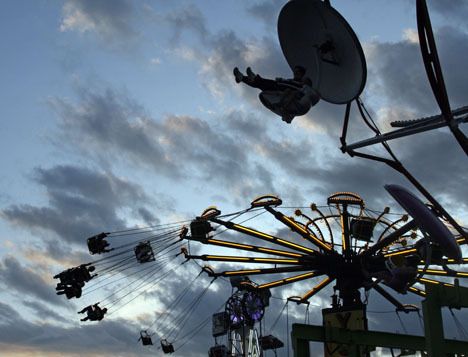The San Juan County Fair will have about $5,000 from the county general fund to help it get through 2010. Whatever else the fair might need to keep itself afloat, it will have to generate on its own.
That’s why a new land-use overlay district has been welcomed with open arms at the headquarters of the county fair. It sets the stage for the fair to host, and to cash in on, an assortment of activities and events that have long been prohibited by land use rules that apply to all 14 acres of the fairgrounds in Friday Harbor.
“That $5,000 doesn’t go very far, but we’ll take it,” said Fair Board President Josephine Bangs of Orcas Island. “With the overlay district, we’ll have an opportunity to rent the facilities out for a few more things than we’ve been able to in the past.”
Among the activities the overlay district would allow outright are conventions, dances, farmers markets, garden shows, meetings, trade exhibitions, workshops, as well as concerts, horse shows, RV and tent camping, and youth programs, as part of the fair and during other events.
The list of allowed uses are subject to review by both the Planning Commission and County Council every five years at minimum.
In a 5-0 decision, the County Council gave tentative approval Feb. 9 to the fairgrounds overlay district. A final decision is expected by the council April 27, at which time it will weigh in on a list of potential changes to the county Comprehensive Plan.
Presently, a conditional use permit approved in the early 1990s dictates the type of activities allowed at the county-owned fairgrounds. That permit supersedes zoning restrictions which normally would apply to original 10 acres of the fairgrounds. It does not extend, however, to a 3.7-acre parcel at the back of the fairgrounds which the county purchased in 2005.
“That piece really can’t be used for what it was intended for when the county bought it,” said county Associate Planner Julie Thompson, who helped to put the overlay district together. “There’s a very limited amount of named uses in that permit.”
Furthermore, Thompson said, activities allowed under that C.U.P which are “non-conforming” cannot be expanded. For example, she said, R.V. hookups can be used only in conjunction with the annual fair.
Though it may prove to be a financial lifeline, Bangs said the overlay district is late in coming. Operating and maintaining the fairgrounds and its facilities is expected to cost roughly $350,000 this year, and the fair, like county parks, has been forced to become more entrepreneurial to make up for what its lost in general fund support in recent years.
“They kind of weaned us off first,” she said. “We kind of have our hands tied behind our backs right now.”
The fair is now evermore dependent on awards and grants to cover its expenses. Historically, it’s been a regular recipient of cash awards from the county’s lodging tax and public facilities financing funds. Those funds, however, ebb and flow on the strength of the local economy, and competition among non-profits for funding has grown increasingly competitive.
The financial outlook for the fair could get worse before it gets better. Bangs said it may lose as much as $30,000 in outside yearly support depending on the outcome of budgetary cost-cutting moves under consideration at the state Capitol. That funding, she added, amounts to roughly 18 percent of the department’s budget and has been used in the past to offset the cost of 4-H and Premium programs of the county fair, such as paying for awards and ribbons for those participating in 4-H events.
Should it be approved, the overly district would require the Fair Board to develop a master plan for the fairgrounds. With the fair on shaky ground, and its future at stake, Bangs said she hopes islanders from all corners of the county will get involved in developing that master plan and to help create a more stable and self-sustaining foundation for the Fair.
“It’s one of those use it or lose things,” she said. “We gotta’ make the fairgrounds work.”




